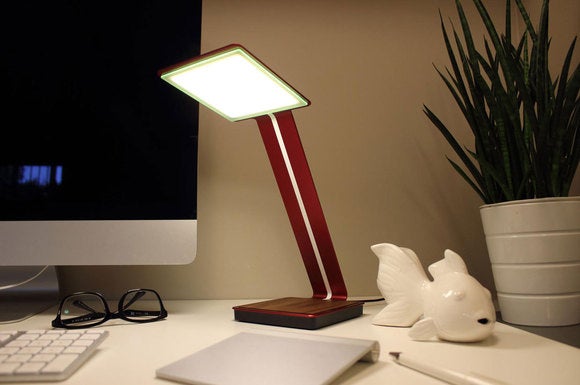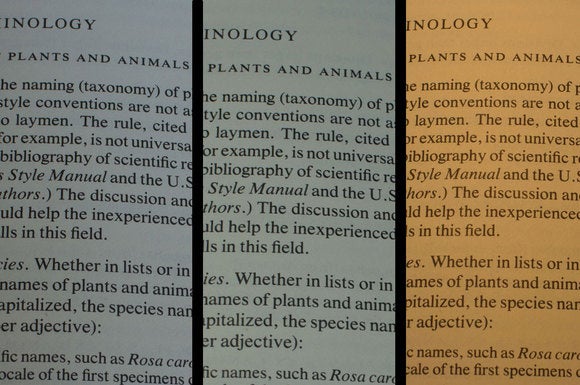
n yesterday’s OLED technology explainer, Jon L. Jacobi noted that organic light-emitting diodes (OLED) technology has applications beyond its use in high-end TVs. The Aerelight A1 desk lamp is a good example: It uses a single five-inch-square OLED to illuminate your desktop work surface. As an object, it’s very pretty. As a desk lamp, it’s not as practical as it could be.
The Aerelight A1 is fabricated from a single piece of brushed aluminum and is available in three anodized finishes: Red, black, or silver. The company says it’s open to the idea of producing additional colors if there’s enough demand. A square of American walnut inset in the base accentuates the lamp’s good looks and delivers a bonus feature I’ll get to in a moment.
This lamp boasts some very cool features: It can produce three levels of brightness, but it doesn’t have a physical on/off switch. To turn it on, you simply touch any part of its metal surface. One touch triggers its lowest brightness, one more brings it to medium, and a third touch cranks it up to maximum. Touching it a fourth time turns it off again. The top of the shade (the surface to which the OLED is mounted) is the most convenient place to tap, but this action causes the lamp to bounce up and down for about 9 or 10 seconds. Touch it again to make it stop and you’ll either increase the brightness or turn it off, depending on which level it’s at. That’s annoying, but it’s not a deal breaker.

MICHAEL BROWN
The hardwood insert in the Aerelight A1’s base hides a Qi electromagnetic induction charger. If you have a compatible phone (or put your phone inside a compatible case), you can charge it by simply placing it on the Aerelight A1’s base—there’s no need to plug in a cable. The company provided a sample case for an iPhone 5/5s that seemed no thicker than most ordinary cases, but I didn’t evaluate it.
At its dimmer levels, the Aerelight A1 barely sips power: My watt-meter measured it drawing just 1.0 watt at its dimmest setting and only 3.0 watts at its mid level. When I increased brightness to its maximum, however, it drew about 10 watts. That made it no more efficient than either a Cree 60-watt-equivalent LED bulb installed in a conventional lamp, or a Ledu L9062 full-spectrum fluorescent desk lamp. On the other hand, it was considerably more efficient than an “energy efficient,” 60-watt-equivalent GE soft-white halogen incandescent that drew 42 watts.
This is purely my personal preference, but I found that I preferred the color of the light that the inexpensive ($60) Ledu lamp over that of the A1’s warm white (Aerelight rates its color at 2900K). As you can see from the photos, the Ledu produced light that was closer to natural sunlight, although it wasn’t nearly as bright (I couldn’t find a lux rating for the Ledu, but Aerelight says the A1 ranges from 100 to 1000 lux at its brightest).

MICHAEL BROWN
I also preferred the Ledu’s height. The A1’s non-adjustable arm lifted the OLED just 11 inches above my desktop. I obviously wouldn’t want it too high, because I wouldn’t want the light traveling directly into my eyes, but I much preferred the Ledu’s adjustable arm, which allowed me to place the shaded fluorescent tube right at eye level, 18 inches above my work surface.
Finally, there’s the Aerelight A1’s $299 price tag to consider. I presume it’s so high because OLED yields are as low for this type of application as they are for the type used in TV manufacturing. The presence of the Qi charging pad can’t be much of a factor, since I’ve seen that in much less-expensive lamps. The Ledu L9062 is as ugly as sin, but you could buy five of them for the price of one Aerelight A1, and you might prefer the cheaper lamp’s light and flexibility
[“source -cncb”]



